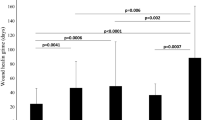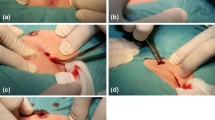Abstract
Background
Various surgical techniques are available in the management of pilonidal sinus, but controversy concerning the optimal surgical approach persists. The present study analyzes the outcome of unroofing and curettage as the primary intervention for acute and chronic pilonidal disease.
Methods
A total of 297 consecutive patients presenting with chronic disease, acute abscess, or recurrent disease were treated with unroofing and curettage. The wound was left open to heal by secondary intention. Hospitalization, time required to resume daily activities and return to work, healing time, and recurrence rates were recorded.
Results
All patients were discharged within the first 24 h after operation. The median period before returning to work was 3.2 ± 1.2 days, and the mean time for wound healing was 5.4 ± 1.1 weeks. Six patients were readmitted with recurrence of the disease within the first six postoperative months. All recurrences were in patients who did not follow the wound care advice and who did not come to regular weekly appointments. Patients with recurrence underwent repeat surgery by the same technique with good results.
Conclusions
Unroofing and curettage for pilonidal sinus disease is an easy and effective technique. The vast majority of the patients, including those with abscess as well as those with chronic disease, will heal with this simple procedure, after which even recurrences can be managed successfully with the same procedure. Relying on these results, we advocate unroofing and curettage as the procedure of choice in the management of pilonidal disease.


Similar content being viewed by others
References
Akıncı OF, Bozer M, Uzunkoy A et al (1999) Incidence and aetiological factors in pilonidal sinus among Turkish soldiers. Eur J Surg 165:339–342
McCallum I, King PM, Bruce J (2007) Healing by primary versus secondary intention after surgical treatment for pilonidal sinus (Review). Cochrane Database Syst Rev 4:CD006213
Arda IS, Güney LH, Sevmiş S et al (2005) High body mass index as a possible risk factor for pilonidal sinus disease in adolescents. World J Surg 29:469–471
Alspaugh D, Hyman N (2001) Pilonidal disease. Prob Gen Surg 18:45–50
Da Silva JH (2000) Pilonidal cyst. Cause and treatment. Dis Colon Rectum 43:1146–1156
Sondenna K, Andersen E, Nesvik I et al (1995) Patient characteristics and symptoms in chronic pilonidal sinus disease. Int J Colorectal Dis 10:39–42
Bissett IP, Isbister WH (1987) The management of patients with pilonidal disease—a comparative study. Aust N Z J Surg 57:939–942
Füzün M, Bakir H, Soylu M et al (1994) Which technique for treatment of pilonidal sinus— open or closed? Dis Colon Rectum 37:1148–1150
Al-Hassan HK, Francis IM, Neglén P (1990) Primary closure or secondary granulation after excision of pilonidal sinus? Acta Chir Scand 156:695–699
Gencosmanoglu R, Inceoglu R (2005) Modified lay-open (incision, curettage, partial lateral wall excision and marsupialization) versus total excision with primary closure in the treatment of chronic sacrococcygeal pilonidal sinus. Int J Colorectal Dis 20:415–422
Kronberg I, Christensen KI, Zimmerman-Nielson O (1986) Chronic pilonidal disease: a randomised trial with complete three year follow up. Br J Surg 72:303–304
Sondenaa K, Andersen E, Soreide JA (1992) Morbidity and short term results in a randomised trial of open compared with closed treatment of chronic pilonidal sinus. Eur J Surg 158:351–355
Rao M, Zawislak W, Gilliland R (2001) A prospective randomised trial comparing two treatment modalities for chronic pilonidal sinus. Int J Colorectal Dis 3(Suppl 1):102 Abstract
Abu Galala KH, Salam IM, Abu Samaan KR et al (1999) Treatment of pilonidal sinus by primary closure with a transposed rhomboid flap compared with deep suturing: a prospective randomised clinical trial. Eur J Surg 165:468–472
Cihan A, Ucan BH, Comert M et al (2006) Superiority of asymmetric modified Limberg flap for surgical treatment of pilonidal disease. Dis Colon Rectum 49:244–249
Ertan T, Koc M, Gocmen E et al (2005) Does technique alter quality of life after pilonidal sinus surgery? Am J Surg 190:388–392
Fazeli MS, Adel MG, Abaschi AH (2006) Comparison of outcomes in Z plasty and delayed healing by secondary intention of the wound after excision of the sacral pilonidal sinus: results of a randomized, clinical trial. Dis Colon Rectum 49:1831–1836
Testini M, Piccinni G, Miniello S et al (2001) Treatment of chronic pilonidal sinus with local anaesthesia: a randomized trial of closed compared with open technique. Colorectal Dis 3:427–430
Mansoory A, Dickson D (1982) Z-plasty for treatment of disease of the pilonidal sinus. Surg Gynecol Obstet 155:409–411
Manterola C, Barroso M, Araya JC (1991) Pilonidal disease: 25 cases treated by the Dufourmentel technique. Dis Colon Rectum 34:649–652
Militio G, Cortese F, Casciani CU (1998) Rhomboid flap procedure for pilonidal sinus: results from 67 cases. Int J Colorectal Dis 13:113–115
Petersen S, Aumann G, Kramer A et al (2007) Short term results of Kardayakis flap for pilonidal sinus disease. Tech Coloproctol 11:235–240
Bascom JU (1981) Pilonidal disease: correcting over treatment and under treatment. Contemp Surg 18:13–28
Parvaiz A, Kennedy R (2001) Bascom’s procedure in the day surgical management of symptomatic pilonidal sinus. Br J Surg 88:155–156
Senapati A, Cripps NP, Thompson MR (2000) Bascom’s operation in the day—surgical management of symptomatic pilonidal sinus. Br J Surg 87:1067–1070
Soll C, Hahnloser D, Dindo D et al (2008) A novel approach for treatment of sacrococcygeal pilonidal sinus: less is more. Int J Colorectal Dis 23:177–180
Stephens FO, Stephens RB (1995) Pilonidal sinus: management objectives. Aust N Z J Surg 65:558–560
Author information
Authors and Affiliations
Corresponding author
Rights and permissions
About this article
Cite this article
Kepenekci, I., Demirkan, A., Celasin, H. et al. Unroofing and Curettage for the Treatment of Acute and Chronic Pilonidal Disease. World J Surg 34, 153–157 (2010). https://doi.org/10.1007/s00268-009-0245-6
Published:
Issue Date:
DOI: https://doi.org/10.1007/s00268-009-0245-6




